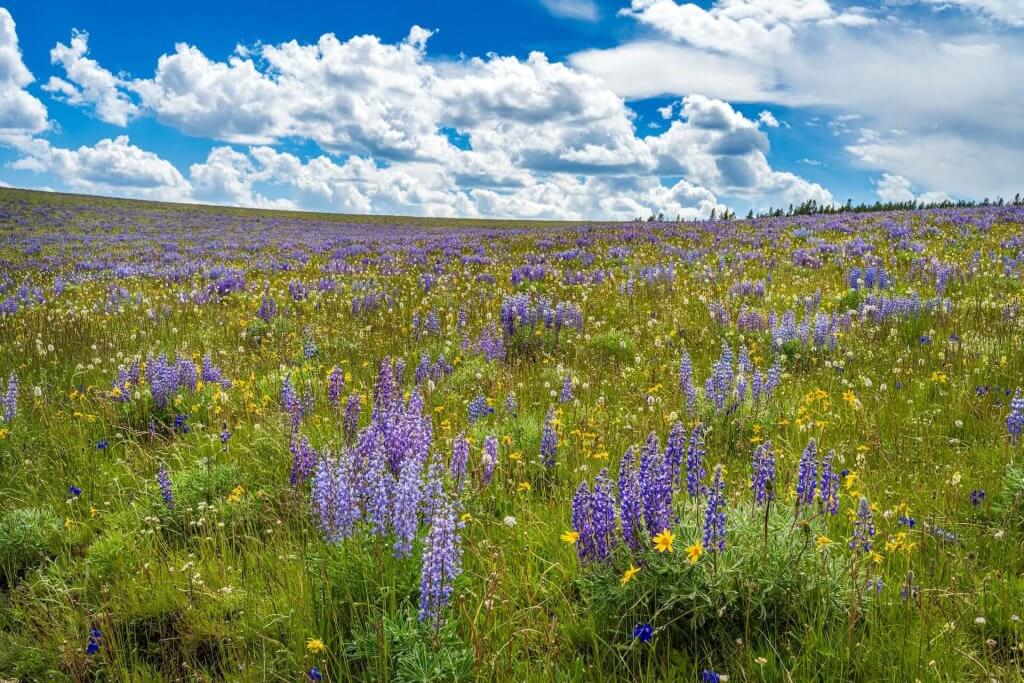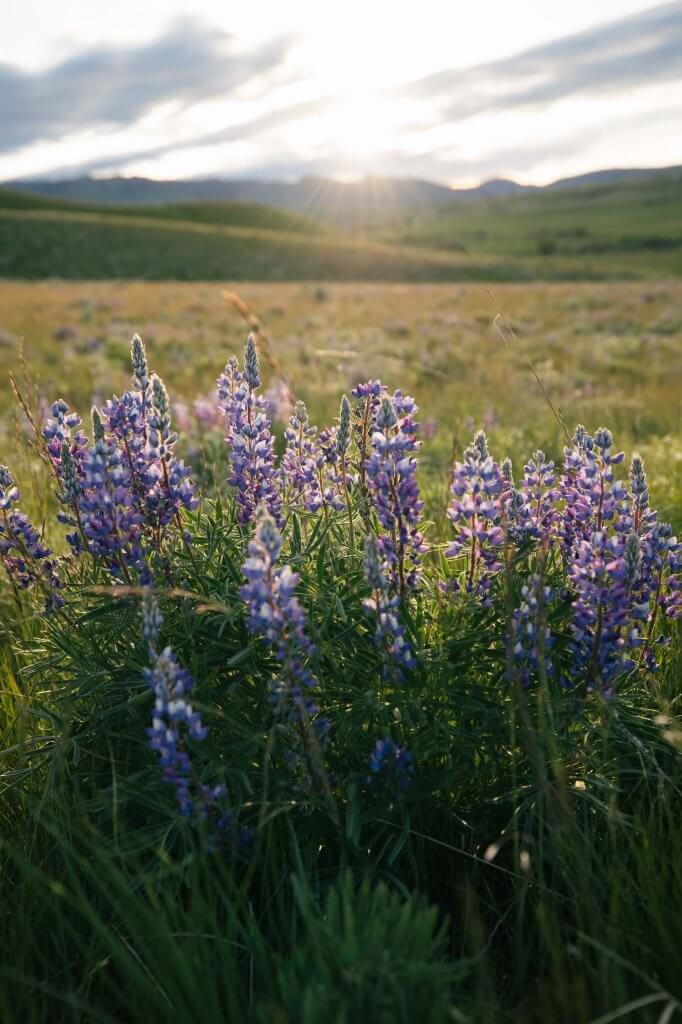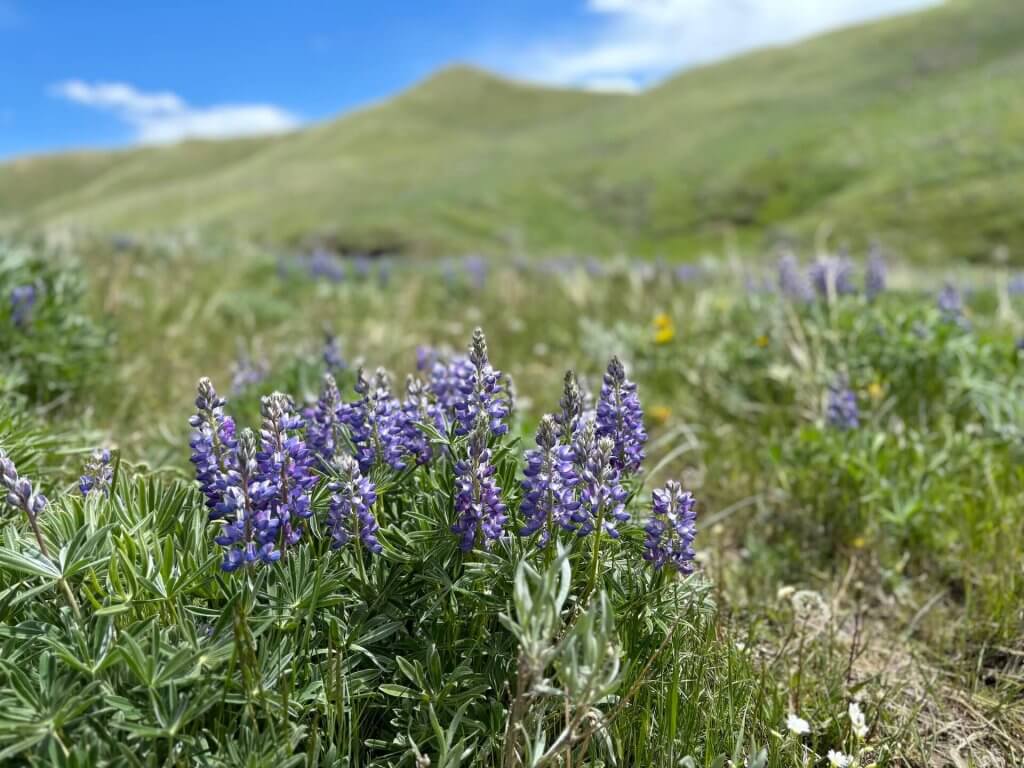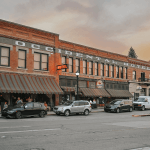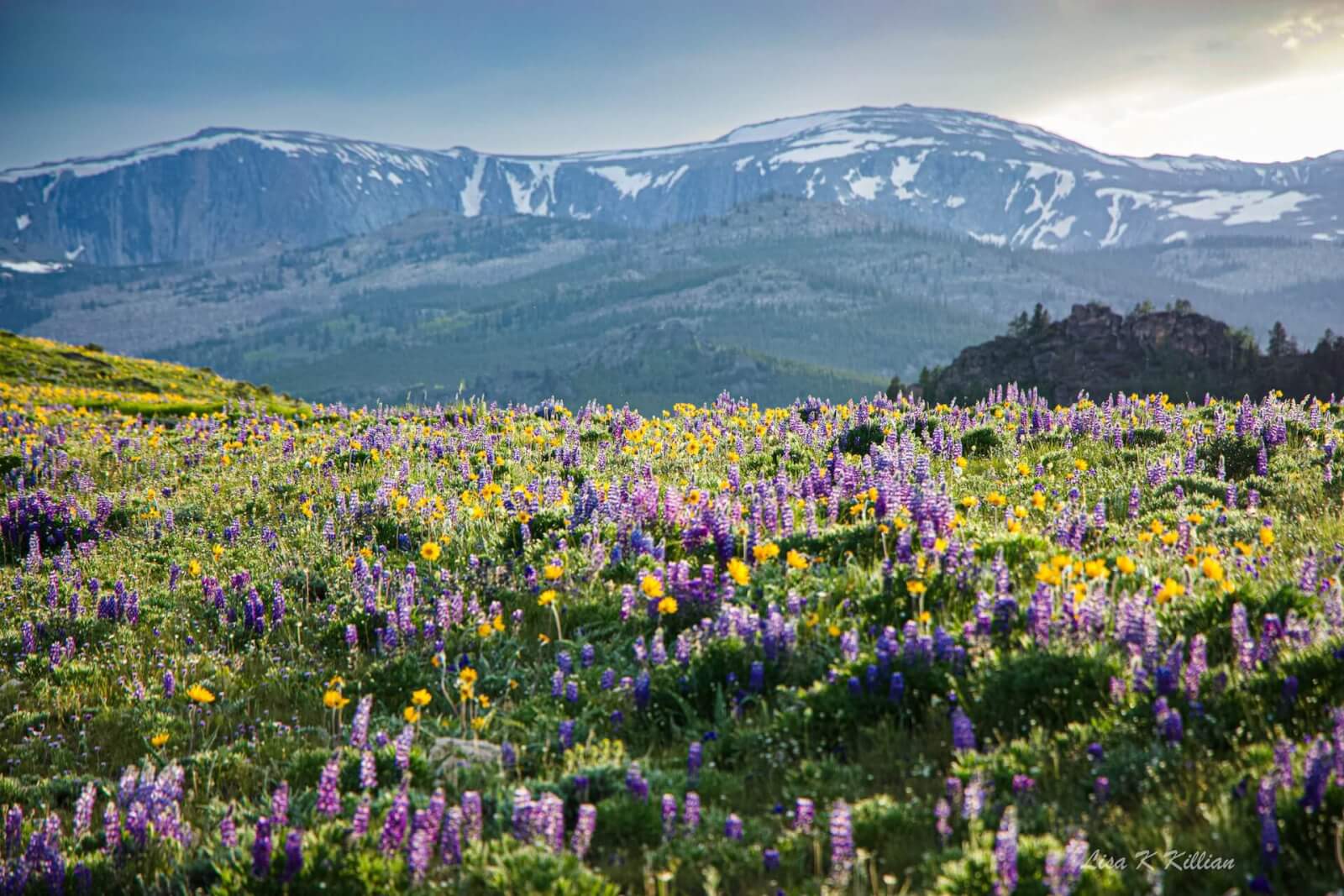
Wyoming Wildflowers: Types and Where to Find Them in Johnson County
For those who like to see natural beauty, wildlife, and native wildflowers, Johnson County is unique among Wyoming counties with its vast array in its types of wildflowers and its diversity.
With the Great Plains rolling into the Bighorn Mountains at elevations surpassing 12,000 feet, Johnson County, WY, has all six vegetation zones present in the state:
- Plains. Broad, flat lands with grasses and crops, found at low elevations.
- Steppe. Dry, treeless grasslands with sparse vegetation and extreme temperatures.
- Foothills. Rolling hills that form a transition between plains and mountains.
- Montane. Forested mountain slopes with cooler temperatures and abundant wildlife.
- Subalpine. High-elevation and steep with meadows just below the treeline.
- Alpine. Rugged terrain above the treeline with hardy plants.
This guide covers the native varieties and types of wildflowers you can find in Johnson County, how to identify them, and where to view them.
When Is Wildflower Season in Johnson County, Wyoming?
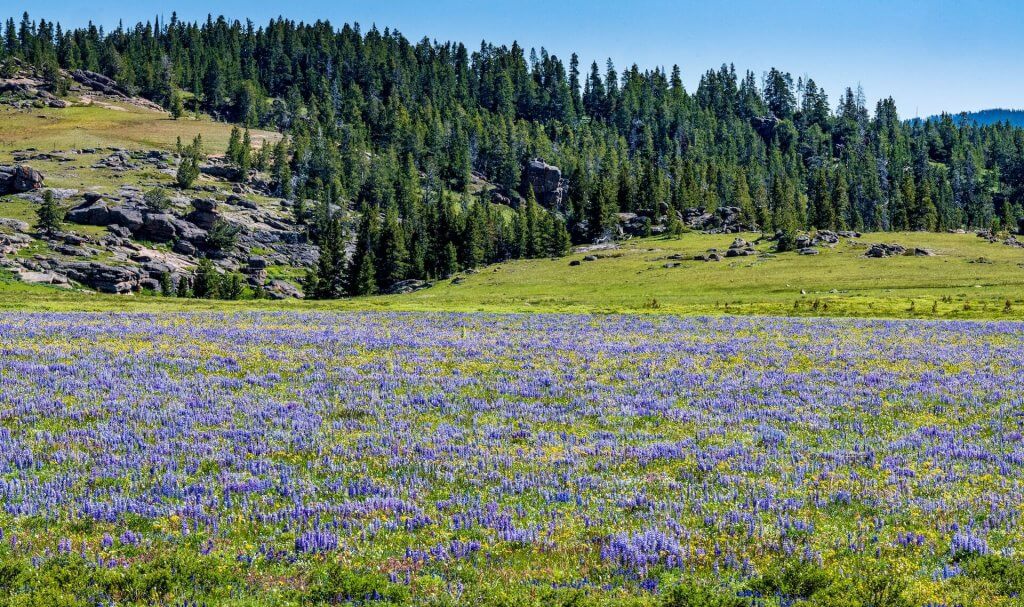
Wildflower season is typically April through August, with peak blooms for native flowers occurring in June in Johnson County, WY.
In April, shortly after the snow melts, wildflowers can be found at lower elevations, and can be present later throughout Johnson County, WY, in July, especially in the Bighorn Mountains.
With the right conditions, wildflowers may even bloom through August. However, each year can be different depending on the weather, especially the amount of precipitation. Again, June is typically the peak month for wildflower viewing in Johnson County.
Types of Wildflowers You Might Spot in Johnson County
While there are several varieties of native wildflowers in Johnson County, Lupine and Arrowleaf Balsamroot can be seen all over the hillsides. The good news is that viewing wildflowers can be as easy or challenging as you like – whether it’s just a drive up Highway 16/Cloud Peak Scenic Byway, a walk along the Clear Creek Trail in Buffalo, or hiking to the open meadows high in the Bighorn National Forest.
Below are the types of wildflowers that may be found in Johnson County, with tips on where to find them and how to recognize them.
Indian Paintbrush (Castilleja spp.)
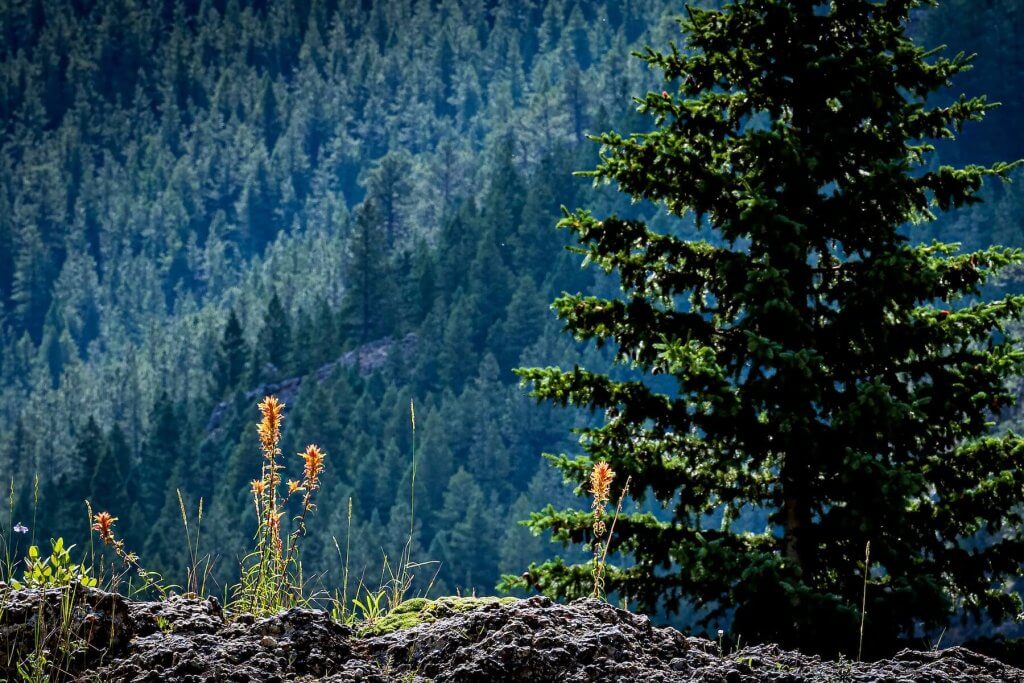
As wyoming’s state flower (in the red variety), this flower native to Wyoming can be seen on the hillsides and roadsides in Johnson County from June to August. Seen in a vibrant array of colors, the Indian Paintbrush can be found in variations of scarlet red, pink, and orange to white. It is named for its resemblance to a ragged brush dipped in paint.
Where to Find Indian Paintbrush in Wyoming
The Indian Paintbrush is very vibrant and great to view and photograph on BLM and state lands throughout Johnson County in May and June. It can be found on public lands around Kaycee in southern Johnson County, but is present in many other areas of the sagebrush steppe.
It can be found on hillsides and roadsides as well as mountain meadows.
How to Identify Indian Paintbrush in Wyoming
The Wyoming Indian Paintbrush has leafy, red bracts with protruding yellow flowers. The leaves are narrow and divided and grow up to 3 inches long. Stems grow up to 2 feet tall.
Lupine (Lupinus spp.)
Lupine are abundant in the Bighorn Mountains, flowering from June through August. It is found in mountain meadows and along the roads. The prolific, hardy plant stands tall and is popular with pollinators.
Where to Find Lupine in Wyoming
Lupine are found in mountain meadows and on slopes. They are hard to miss in the mountain meadows along Highway 16, standing out with their purplish stalks. They are found along Clear Creek Trail in Buffalo and throughout the Bighorns at places such as Hospital Hill, Grouse Mountain, Schoolhouse Park Road, Loaf Mountain Overlook, and Poison Creek Trail.
The primary flowering season for Lupine is June through August in Wyoming.
How to Identify Lupine in Wyoming
The Silvery Lupine has heads of blue and purple pea-like flowers that grow on long stalks. Linear leaves fan out from the central node like the palm of a hand. They can grow 20 to 30 inches tall.
Arrowleaf Balsamroot (Balsamorhiza sagittata)
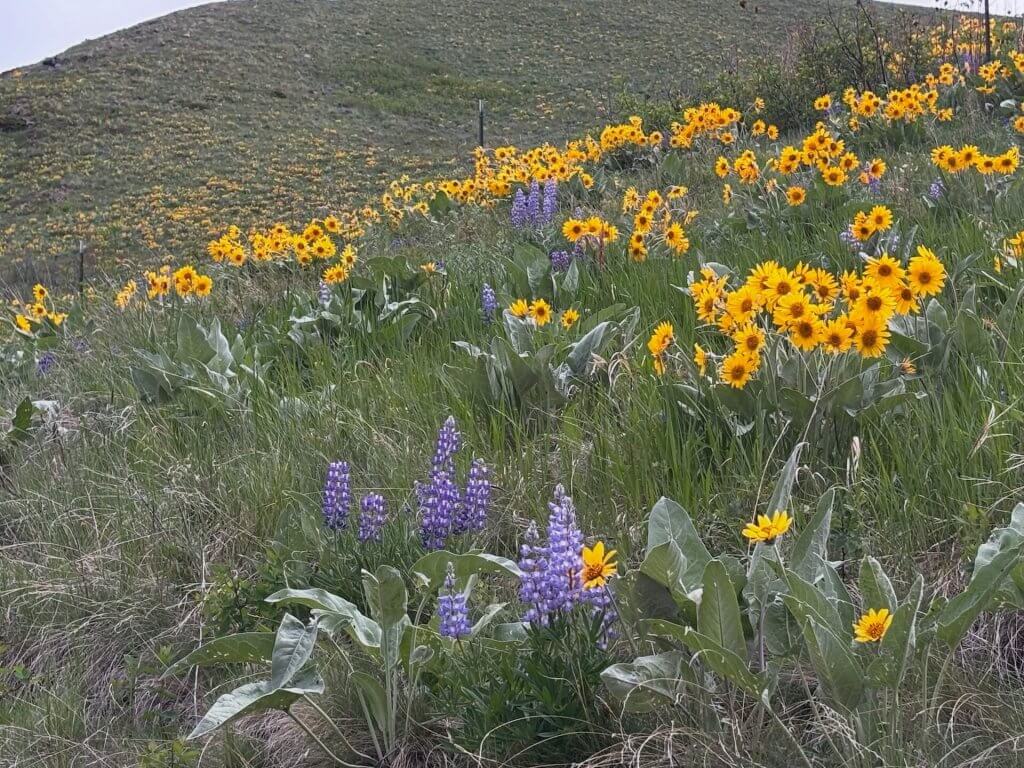
The Arrowleaf Balsamroot is frequently confused with small sunflowers and is present throughout the Bighorns. Golden yellow in color, it blooms early in the widflower season, often in late April. They can bloom into the fall.
Where to Find Arrowleaf Balsamroot in Wyoming
Arrowleaf balsamroot can often be found in fields of lupine. In Johnson County, it can be seen in grassy openings near Mosier Gulch and in the fields around Hospital Hill just west of Buffalo. But throughout the meadows along Highway 16, the arrowleaf balsamroot is prevalent.
Deer, elk, and pronghorn enjoy the leaves, stems, and flowers.
How to Identify Arrowleaf Balsamroot in Wyoming
The bright yellow leaves are shaped like arrowheads, giving the plant its name, while the centers may be yellow or gold in color. The leaves are often covered in soft, silvery hairs.
Hoary Balsamroot (Balsamorhiza incana)
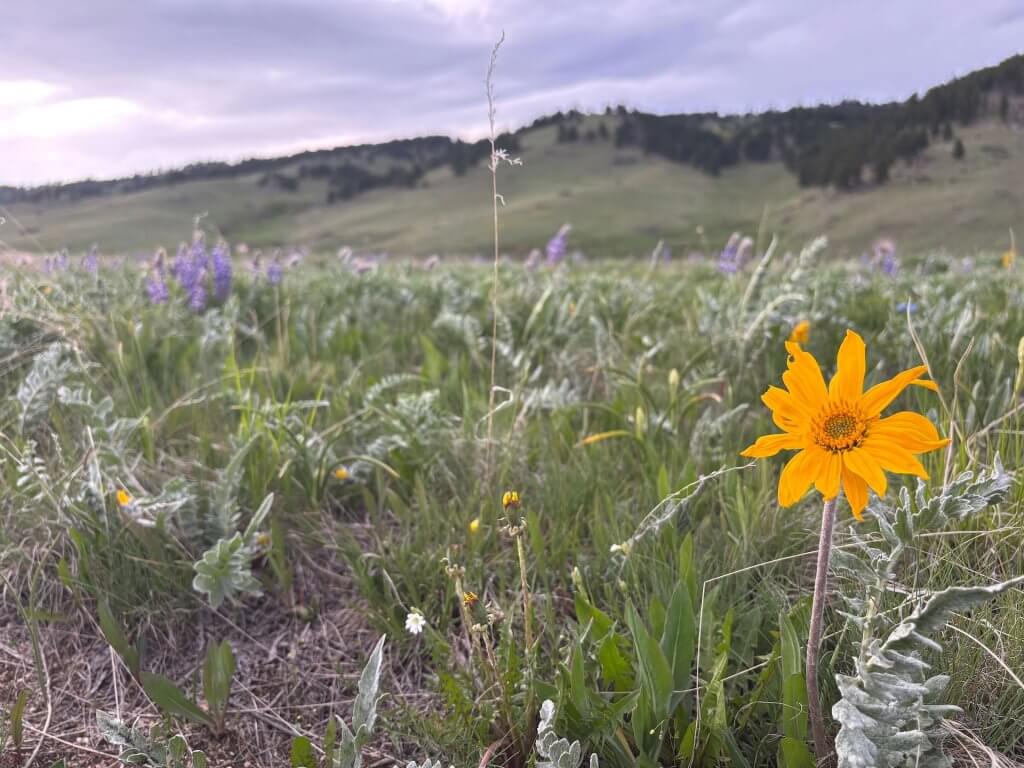
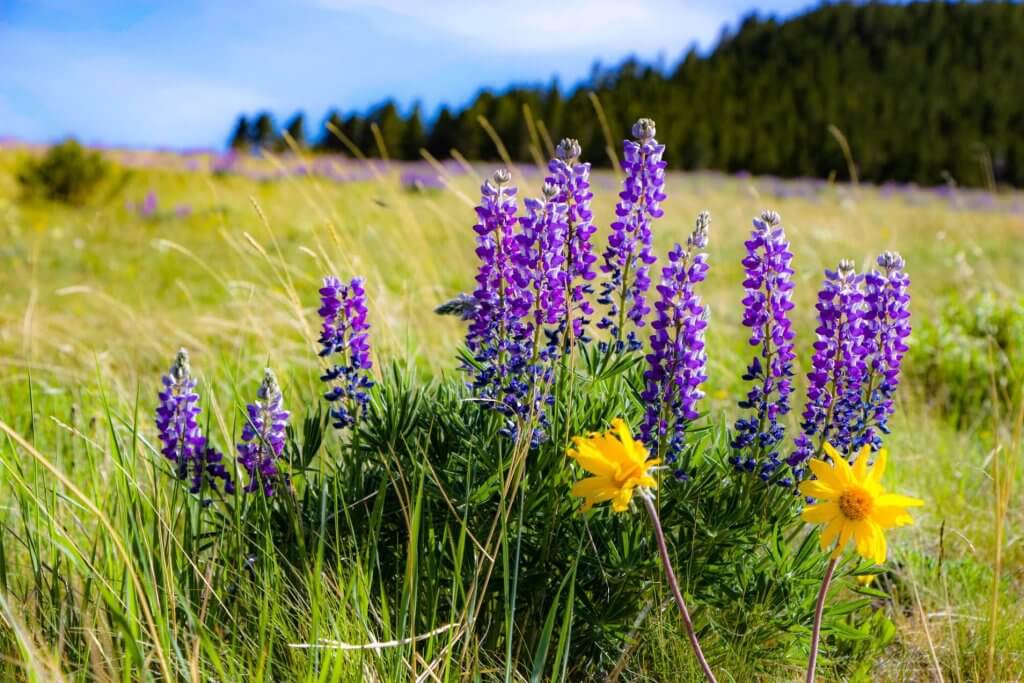
The Hoary Balsamroot has densely hairy, deeply notched basal leaves. They grow up to 8 inches long, a little smaller than the Arrowleaf Balsamroot..
Where to Find Hoary Balsamroot in Wyoming
Hoary is the most common Balsamroot in the Grouse Mountain and Hospital Hill areas, as Arrowleaf Balsamroot fades out on the face of the mountain.
Pasqueflower (Pulsatilla patens)
The Pasqueflower is one of the earliest blooming flowers, observable as early as March in fields and meadows above 4,000 feet. They bloom as late as June in higher elevations. The pale purple sepals and stark yellow stamens make it stand out from other wildflowers.
Where to Find Pasqueflower in Wyoming
Pasqueflower can be found in the prairies in sandy, well-drained soils. It can also be found in steppe and foothill terrain. It can be found around the Grouse Mountain area before other wildflowers bloom, often as early as April, as the snow is melting off.
Check also in the sunny forest edges and dry hillsides in the Bighorn foothills. Tie Hack Reservoir and Soldier Creek are also among the places to look for pasqueflower.
How to Identify Pasqueflower in Wyoming
Also known as windflower, the pasqueflower is lavender in color with a large, deep (up to 1½ inches) cup shape. They have five to seven petal-like sepals and are hairy on the outside with yellow stamens in the center. They occur on upright stems that grow 4 to 16 inches tall.
Yarrow (Achillea millefolium)
Yarrow consists of pretty flat-topped clusters of white flowers in an umbrella-like shape. They grow up to 18 inches in height. They are hearty and widespread, visible in meadows, fields, and along trails.
Where to Find Yarrow in Wyoming
Yarrow can be found in almost all of the vegetation zones throughout Johnson County, especially those starting at the base of the mountains and going up in elevation.
The hardy plants thrive in open and disturbed areas.
How to Identify Yarrow in Wyoming
The flower heads of a Yarrow are ¼-inch across with three to five white, ray-shaped flowers. Yarrow blooms from June to September and grows in dry to moist soils. They have a strong, aromatic odor.
Western Columbine (Aquilegia formosa)
Also known as Red Columbine, Western Columbine are showy, large flowers with red sepals and yellow petals. They grow at higher elevations – foothills to alpine – and in woodland habitat.
Where to Find Western Columbine in Wyoming
Western Columbine thrives in shady, moist areas near Circle Park or the South Fork of Clear Creek. The high elevation trails provide the cool, protected habitat it favors.
How to Identify Western Columbine in Wyoming
The Red Columbine blooms in June and July. It has distinctive red sepals and yellow petals with stamens extending out. On tall stems, its lace-like leaves stand out even in shaded areas.
Shooting Star (Dodecatheon pauciflorum)
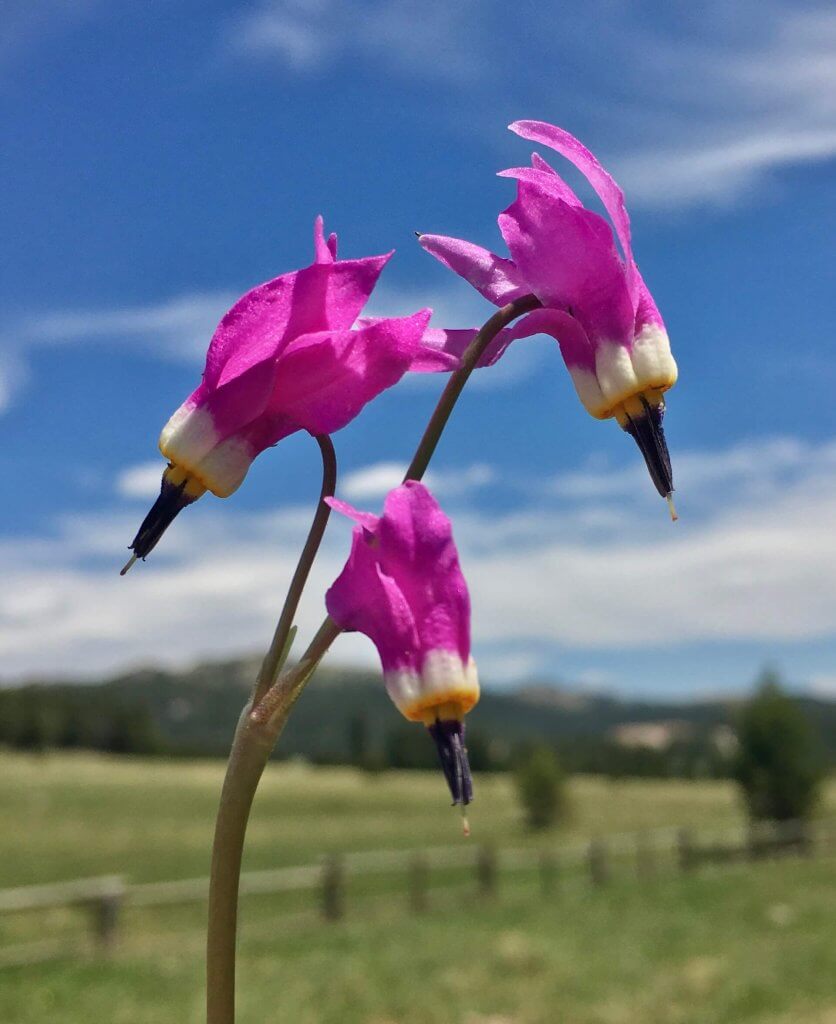
The Shooting Star is a distinct flower with purple-pink leaves curving from a cone of stamens with a yellow collar and a point of purple anthers. The flowers’ shape is an adaptation to pollination, as bumblebees shake the pollen loose with the vibration from their wings.
The “theoi” part of the name comes from the Greek word for gods, meaning the plants protected by the gods.
Where to Find Shooting Star Wildflower in Wyoming
Shooting Stars bloom in late April, making it one of the earliest flowers, through July. It is seen in open fields and often interspersed with forget-me-nots.
How to Identify Shooting Star Wildflower in Wyoming
The flowers of the Shooting Star look like deep purple-pink darts that point in all directions from a long stalk. They are ¾ to 1 inch long. The stamens are fused to point down like a dart or beak.
Fairy Slipper Orchid (Calypso bubosa)
Fairy Slipper Orchids are found in moist, rich soils and cool, shady areas. A somewhat uncommon plant, it does not survive transplanting, so you are asked to enjoy it but not pick it or dig it.
Where to Find Fairy Slipper Orchid in Wyoming
The Fairy Slipper Orchid is seen in forest settings near decayed stumps and logs. It can be seen from late May to late June..
How to Identify Fairy Slipper Orchid in Wyoming
The Fairy Slipper has a single, egg-shaped basal leaf and a 2- to 5-inch flower stalk. There is a single, inflated lower lip of brownish pink and mottled purple, topped by two pink petals and three pink sepals.
Yellow Bells (Fritillaria pudica)
Known as Yellow Bells, Yellow Fritillary, Yellow Trumpetbrush, and Esperanza, this flower produces attention-grabbing yellow blossoms.
Where to Find Yellow Bells in Wyoming
Yellow Bells bloom in valleys as early as mid-March and in the foothills and higher elevations during May and June. It can be found among sagebrush and on dry hillsides..
How to Identify Yellow Bells in Wyoming
The bright yellow flowers stand out against the odd-pinnate green leaves. The corolla is bell- or funnel-shaped with five lobes, often featuring a reddish vein in the throat.
Sego Lily (Calochortus nuttallii)
The Sego Lily is a tulip-like flower that blooms in June and early July.
Where to Find Sego Lily in Wyoming
The Sego Lily can be found on sagebrush-covered hillsides and throughout the sagebrush steppe in eastern Johnson County.
How to Identify Sego Lily in Wyoming
It has slender stems that grow 4 to 12 inches tall, and the solitary white flowers have three petals with a purple, crescent-shaped band at their base, and three pointed, greenish to white sepals.
Harebell (Campanula rotundifolia)
The Common Harebell is a very common wildflower that grows in semi-dry locations throughout Wyoming. Called the bluebell of Scotland, its thickness and beauty feed into the legend that it provides shelter to fairies. Other legends say the flower’s juice was used by witches to transform themselves into hares.
Where to Find Harebell in Wyoming
The Harebell can be found in low elevations and all the way to 10,000 feet. It can be found in sunny meadows as well as woods, and is often mixed in with sagebrush. It blooms from mid-June to August.
How to Identify Harebell in Wyoming
The Harebell is purple to light blue in color and has small, round basal leaves and narrow stem leaves. It occurs in clusters on the ends of slender stems.
Blazing Star (Mentzelia laevicaulis)
The Blazing Star only opens at night and blooms from late June through early August.
Where to Find Blazing Star in Wyoming
The Blazing Star is unique in that it can be found in road cuts and open areas where the soil has been worked..
How to Identify Blazing Star in Wyoming
The Blazing Star has large yellow flowers up to 3 inches across with five pointed petals. It grows up to 18 inches tall.
Yucca (Yucca glauca)
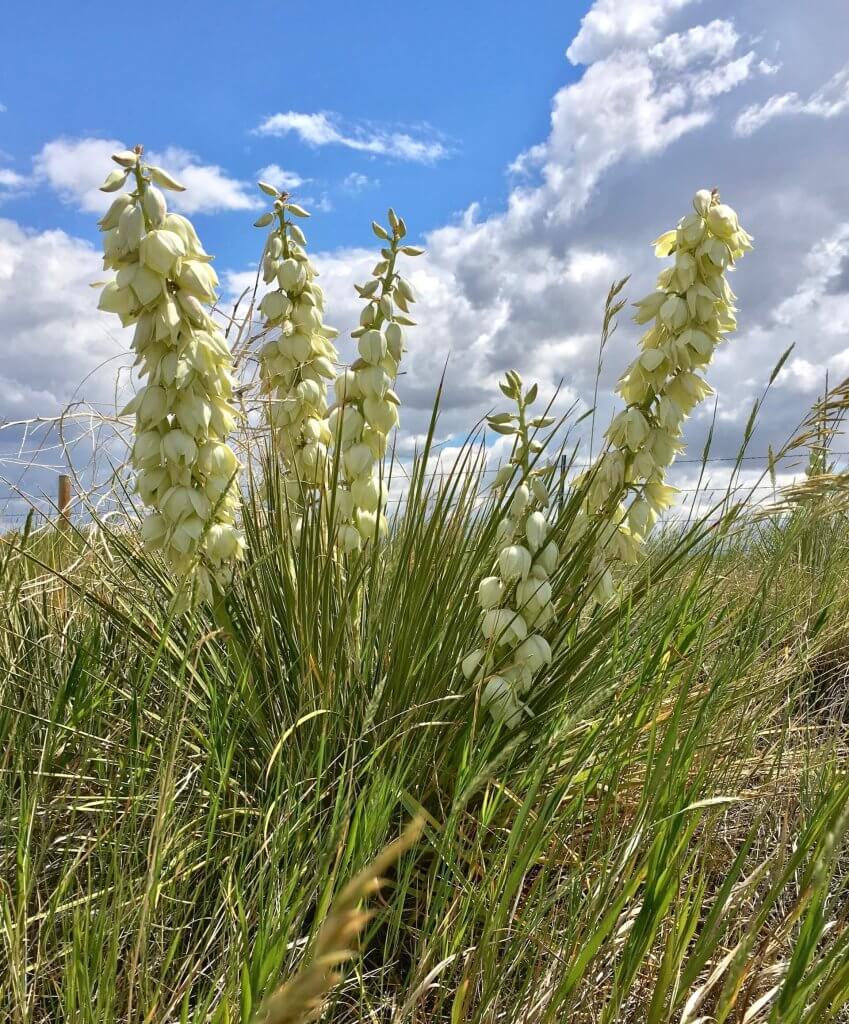
Yucca stands like a sentinel and are common on roadsides, including the interstates of Johnson County. Part of the agave family with succulent leaves, the Yucca was used by Native Americans for soap (roots), fiber (leaves) and needles (leaf tips).
Where to Find Yucca in Wyoming
The plant is common in the prairies and foothills as well as the Great Plains, which are present in eastern Johnson County. Yucca plants enjoy the sandy soils in the plains east of the mountains.
How to Identify Yucca in Wyoming
Yuccas have sharply pointed, simple basal leaves. They have nodding, white or light green flowers with three petals and three petal-like sepals. They bloom in June and July and grow 36 to 48 inches tall.
Chickweed (Cerastium arvense)
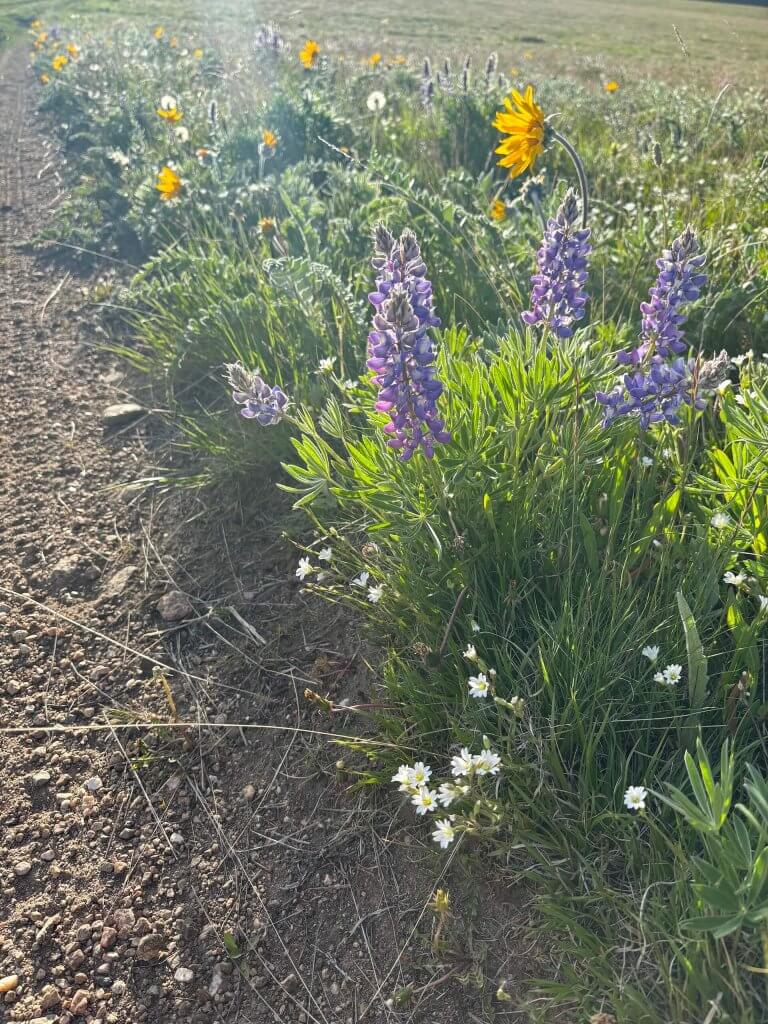
With white and yellow coloring, chickweed adds a nice splash of color against the green grasslands and other native flowers..
Where to Find Chickweed in Wyoming
Chickweed is widespread in the Bighorns and the prairies. It blooms from May to August and enjoys dry, rocky terrain.
How to Identify Chickweed in Wyoming
Chickweed flowers have five white petals that have notches at the tops, making them look like two separate petals. They grow 2 to 12 inches tall with trailing stems.
Beardtongue (Penstemon spp.)

More than 40 species of Beardtongue can be found in Wyoming, including at various locations throughout the Bighorn Mountains. There are many similarities among them. Most are blue and purple. The stamens are bearded with yellow hairs, giving the flowers their name.
Where to Find Beardtongue in Wyoming
Low Beardtongue, with blue flowers about ½ inch long, can be found in foothill to alpine zones in central Wyoming.
How to Identify Beardtongue in Wyoming
All Beardtongues have simple, opposite leaves and irregular flowers with five petals. The petals are in a two-lipped tube, and of course, look for the stamens with yellow hairs.
More Varieties of Wildflowers in Johnson County, WY
- American Bistort (Polygonum bistortoides) is common in the Bighorn Mountains in Johnson County andis seen as little white tufts. They begin blooming in early July and can be seen in high mountain meadows through August.
- Mountain Goldenbanner (Thermopsis montanum) are yellow, lupine-like flowers that bloom in dense clusters at a similar time of year. It has only three leaflets, fewer than Lupines.
- Desert Primrose are found in desert- and grassland-like conditions. They have four perfectly shaped heart petals in white and sometimes pink. They are a very delicate flower that blooms while it is often cooler out.
Tips for Responsible Wildflower Viewing
Enjoying the wildflowers in Johnson County is a great experience, and it’s one we hope that visitors can enjoy for years to come. Please follow these tips to enjoy the flowers, preserve the area’s natural beauty, and ensure future blooms thrive for the enjoyment of future generations.
1. Stay on the Designated Trails to Protect the Wildflowers
There are great trails throughout Johnson County and the Bighorn National Forest that allow visitors to view wildflowers. Venturing off these trails or trying to find shortcuts can damage fragile plants and compact the soil, making it harder for flowers to grow back. Stay on the trail, bring a good camera to zoom in and get great pictures, but please don’t walk through wildflower meadows.
2. Avoid Picking and Leave the Wildflowers for Others to Enjoy
We all want future generations to enjoy the flowers. And the flowers are so important for pollinators. That’s why picking flowers, digging up plants, or disturbing natural areas is frowned upon. Take photos, and leave the blooms that help pollinators and allow other visitors to enjoy the same beautiful scenery.
3. Respect Wildlife and Fellow Hikers
While you are out enjoying wildflowers, you might run into wildlife, as well as fellow hikers or sightseers. Moose, elk, deer ,and other animals like to eat wildflowers, so if they are snacking, observe from a distance. Use trail etiquette: stay to the right except when passing, yield to uphill hikers, carry out your trash, etc.
A respectful approach leads to a better outdoor experience for everyone.
Wyoming Wildflower Resources
Pick up Wildflowers of Wyoming by Diantha and Jack States, which can also be found at the Johnson County Library in Buffalo.
The U.S. Forest Service Office, 1415 Fort St. in Buffalo, Wyoming, is a great source of information with brochures about wildflowers and much more related to the Bighorn National Forest.
Discover the Blooming Beauty of Wildflowers in Johnson County, WY
Wildflowers are just one reason to enjoy a visit to Johnson County, Wyoming, in the spring or summer. With small-town hospitality, plenty of lodging and camping options, and great hiking, Johnson County is the perfect destination for a relaxing spring or summer getaway.
While visiting to enjoy the blooming wildflowers and possibly see the wildlife, guests can also enjoy the museums, historic site,s and charming downtown as well as the wide-open spaces and recreational opportunities.
